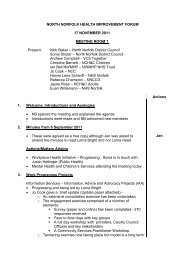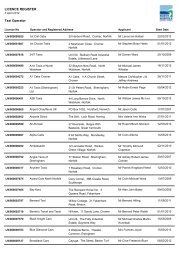Non-Technical Summary - EACG
Non-Technical Summary - EACG
Non-Technical Summary - EACG
- No tags were found...
Create successful ePaper yourself
Turn your PDF publications into a flip-book with our unique Google optimized e-Paper software.
Kelling to Lowestoft Ness Shoreline management Plan <strong>Non</strong>-<strong>Technical</strong> <strong>Summary</strong>3ContentsForewordKelling to Lowestoft Ness..................................................................................................................... 11 <strong>Non</strong>-<strong>Technical</strong> <strong>Summary</strong> .................................................................................................................. 11.1 What is a Shoreline Management Plan? ................................................................................. 11.2 How Our Coast Works ............................................................................................................. 31.3 A History of the Kelling to Lowestoft Ness Shoreline Management Plan. ............................... 41.4 Finalising the SMP ................................................................................................................... 41.5 The Sustainable Approach ...................................................................................................... 51.6 Policy Units .............................................................................................................................. 61.7 Policy Overview ..................................................................................................................... 131.8 Taking Action ......................................................................................................................... 15
Kelling to Lowestoft Ness Shoreline management Plan <strong>Non</strong>-<strong>Technical</strong> <strong>Summary</strong>FOREWORDThe final version of the SMP (first review) includes some critical changes in its approach to policysetting, which have been identified in response to comments and concerns raised by localcommunities after the publication of the draft report in 2006. In this <strong>Non</strong>-<strong>Technical</strong> <strong>Summary</strong> of theShoreline Management Plan (SMP) it is not possible to fully convey the complexity of issues that hashad to be considered in identifying policy options for this coast. The full text also identifies the risksand uncertainties that cannot be resolved within the SMP, and, most importantly, the actions that needto be taken in order to resolve these issues in the future.We would therefore strongly encourage you to read the full text of the SMP, which can be found athttp://www.eacg.org.uk/The contents of the full document include the following:1 Introduction1.1 The Shoreline Management Plan1.2 Structure of the SMP1.3 The Plan development process2 Environmental Assessment: meeting requirements of an SEA2.1 Background2.2 The appraisal process2.3 Stakeholder engagement2.4 The existing environment2.5 Environmental objectives2.6 Identification and review of possible policy scenarios2.7 Environmental effects of the Plan2.8 Monitoring Requirements3 Basis for development of the Plan3.1 Historical perspective3.2 Sustainable policy4 The Shoreline Management Plan4.1 Plan for balanced sustainability4.2 Predicted implications of the Plan4.3 Managing the change5 Policy statements5.1 Introduction5.2 Content6 Action Plan6.1 Introduction6.2 Action Plan Objectives6.3 Preparing for a new policy of managed realignment or no active intervention6.4 The action plan6.5 Management of SMP until next review
Kelling to Lowestoft Ness Shoreline Management Plan <strong>Non</strong>-<strong>Technical</strong> <strong>Summary</strong>11 <strong>Non</strong>-<strong>Technical</strong> <strong>Summary</strong>1.1 WHAT IS A SHORELINE MANAGEMENT PLAN?A Shoreline Management Plan (SMP) provides a large-scale assessment of the risks associated withcoastal erosion and flooding for a particular section of the coast. SMPs have been developed for thewhole of the coastline of England and these build upon the first round of SMPs which were producedin the mid 1990s. The SMP presents a policy framework to address risks to people and the developed,historic and natural environment in a sustainable manner and is intended to inform policy setting andplanning decisions over the next 100 years. Within the overall 100 year time frame, processes andpolicies are considered for the short, medium and long term. The SMP sets out a route that can befollowed to manage the coast sustainably, identifying changes of policy needed over time. SMPs willcontinue to be reviewed and updated periodically to ensure the policies are still appropriate and arebased on the most up to date information.The objectives of the SMP are as follows:to define, in general terms, the risks to people and the developed, natural and historicenvironment, within the area covered by this SMP, over the next century.to identify sustainable policy options for managing those risks.to identify the consequences of implementing these policy options.to set out procedures for monitoring the effectiveness of the SMP policy options.to identify areas that the SMP cannot address when following current guidelines.to inform others so that future land use and development of the shoreline can take dueaccount of the risks and SMP policy options.to comply with international and national nature conservation legislation and biodiversityobligations.
Kelling to Lowestoft Ness Shoreline Management Plan <strong>Non</strong>-<strong>Technical</strong> <strong>Summary</strong>31.2 HOW OUR COAST WORKSThe coast of England is divided up into 26 coastal cells, which are illustrated on the following plan.
Kelling to Lowestoft Ness Shoreline Management Plan <strong>Non</strong>-<strong>Technical</strong> <strong>Summary</strong>4This SMP covers the length of coast between Kelling Hard in North Norfolk and Lowestoft Ness inSuffolk. This area includes some of the most famous and scenic stretches of coastline in England.The north western part is elevated with clay cliffs dominating the coastline. Sections of this coast arevery prone to cliff erosion. The section of the coast in front of the Norfolk Broads is much flatter and isfronted by extensive dunes and broad sandy beaches. This section of the coast is liable to erosionand flooding as the land behind the coastal strip is at or below sea level. South of this the land behindthe coast rises again and is less vulnerable to coastal flooding, but there are still areas that are proneto coastal erosion.This section of shoreline is largely self-contained with respect to coastal processes. There is a verylittle alongshore sediment transport at the boundaries of this coastal cell and therefore the policies setout within this SMP will not affect the coastlines of the neighbouring SMP units.1.3 A HISTORY OF THE KELLING TO LOWESTOFT NESS SHORELINEMANAGEMENT PLAN.This section of coast was originally within two SMP areas, both published in 1996. The majority of thecoast was included in the Sheringham to Lowestoft Plan and the remaining section in the west wascovered by the Snettisham to Sheringham Plan.In March 2006 the first draft of the SMP for the Kelling to Lowestoft Ness section of coast waspublished as a pilot study, testing the implementation of new guidance for SMPs. Since the first planwas produced there had been a range of national studies undertaken including Futurecoast, Foresight,UK Climate Impacts Programme. These studies provided new information, and in light of this, it wasacknowledged in new guidance that the current shoreline management policies may no longer bepractical or acceptable in the long term. This new plan also considered the changes to the coast overa much longer time frame (one hundred years).An extensive public consultation exercise was undertaken during the preparation of the Kelling toLowestoft Ness SMP (First Review). This generated 2,430 responses, predominantly objections, fromresidents, businesses, Parish Councils and other organisations. Since this time, there have beendiscussions between the local authorities and a variety of key local groups. These have helpeddevelop a better understanding of the concerns and helped the various parties to begin to worktogether towards an agreed final document. In particular, neither the original SMPs nor their draftreplacement addressed the consequences of proposed shoreline management policies for people andcommunities. This has proved to be one of the major areas of concern for affected coastalcommunities.1.4 FINALISING THE SMPIn November 2008, the local authorities together with the EA and supported by consultants began theprocess of finalising the Kelling to Lowestoft Ness SMP First Review, taking into account the issuesraised and the modifications already made by the different local authorities. This process includes
Kelling to Lowestoft Ness Shoreline Management Plan <strong>Non</strong>-<strong>Technical</strong> <strong>Summary</strong>6coastal change. The Government published ‘Adapting to Coastal Change: Developing a PolicyFramework’ in March 2010, which states that:“Government is committed to maintaining sustainable coastal communities. This means that, wherecoastal change happens, all aspects of the affected communities need to be supported to help ensurethey remain attractive places for people to live in and visit, and support thriving local economies. Localcommunities need to be informed, engaged and enabled to take an active part in deciding whathappens locally.”While the timing of policy changes may be uncertain, the SMP provides guidance on howcommunities, including individuals, can adapt to coastal change now and in the future. A key aspectof this is likely to be the role of the local planning authorities in preparing their local planning policies.1.6 POLICY UNITSThe SMP encompasses the stretch of the coastline between Kelling in the north and Lowestoft Ness inthe south. Along this section of the coast there are five commercial centres, Sheringham, Cromer,Great Yarmouth, Gorleston and Lowestoft. Between these centres there are a number of smallertowns and villages situated within agricultural land. Also located along this section of the coastline arethe Norfolk Broads which is Britain’s largest nationally protected wetland totalling 303 sq km. The areacomprises rivers, shallow lakes, marshes and fens formed through the reclamation of land whichbegan in the thirteenth century. This area is internationally important both for its conservation valueand tourism and recreation, attracting over two million visitors per year.This SMP constitutes SMP 6 in England. Within this the coastline has been divided up into a further 24policy units. The following sections provide a brief overview of the policy units.Kelling Hard to Cromer – Policy Units 6.01 to 6.04The towns of Sheringham and Cromer provide two of the main centres in the whole of North Norfolk. These townsare both situated on the northward facing shoreline, which is characterised by low rates of sediment transport andrelative stability when compared with much of the rest of the SMP coastline. Furthermore, sediment from theeroding cliff between these towns provides little contribution to beaches beyond these points. Therefore bothSheringham and Cromer can be protected for the foreseeable future without unduly compromising protection ofother frontages. Both towns have a range of facilities that service other communities in the area and are keylocations for local trade, including the tourism industry. There is strong justification for seeking to prevent erosionof these particular frontages and the consequent loss of properties and services.
Kelling to Lowestoft Ness Shoreline Management Plan <strong>Non</strong>-<strong>Technical</strong> <strong>Summary</strong>76.016.02: 6.036.04It is unlikely in the long term that any beach would exist in front of the Cromer and Sheringham defences;therefore the character of these frontages would alter, although some beach would probably still exist betweenthese two towns, due to erosion being allowed to continue.Apart from the towns of Sheringham and Cromer, it is highly improbable that there would be economic justificationfor future defence. Therefore, the Plan is to allow retreat once existing structures reach the end of their effectivelife.East of Cromer to Happisburgh – Policy Units 6.05 to 6.12This is the most physically active length of coast within the SMP area and is the main provider of sediment forbeaches throughout much of the SMP frontage. Erosion of this section of coast is desirable to (a) allow beaches tobuild, which will help avoid accelerated erosion of the shorelines here and elsewhere and thus provide betterprotection to towns and villages, and (b) satisfy nature conservation and biodiversity requirements.Because of the rapid natural erosion rates here, fixing the shoreline in any location would result in a sizeablepromontory forming. Along this section, this would act as a ‘terminal groyne’ in the long term, with material
Kelling to Lowestoft Ness Shoreline Management Plan <strong>Non</strong>-<strong>Technical</strong> <strong>Summary</strong>8reaching this point more likely to be deflected offshore and lost altogether rather than either remaining as a beachin front of these defences or reaching destinations down coast.However, there are numerous assets that would be affected by wholesale abandonment of defences through thisarea, notably the sizeable villages of Overstrand and Mundesley, Bacton gas terminal, and the smaller settlementsof Trimingham, Bacton, Walcott and Happisburgh. The continued defence of these areas may not be sustainablein the long term for the reasons highlighted above. In some cases it is also highly unlikely that such a policy couldcontinue to be economically justified in the long term. Consequently, the policy options for this area need to allowfor managed change, continuing to provide defences where justifiable for the immediate future, but with a longterm Plan to gradually retreat and relocate, thus enabling a naturally functioning sustainable system to reestablish.Both Overstrand and Mundesley will continue to develop as promontories if their present positions are defended.This would result in as much as 70% of the sediment supply to beaches throughout the SMP area being isolatedor lost offshore. Similar arguments apply to Bacton gas terminal. Consequently, the most sustainable approach forthe SMP as a whole is to manage a retreat at these locations in the medium to long term, although the timings ofany change are not certain. It would, though, require the relocation of a large number of people, property andservices within these settlements. The Plan will therefore seek to maintain present defences for a period of time toallow the important social mitigation measures and mechanisms required to facilitate such changes to be put inplace. It is important to note that should a policy of retreat not be adopted at all locations, this would put into doubtthe policy options set elsewhere along this stretch and to Winterton to the south.6.056.066.076.086.096.106.116.12
Kelling to Lowestoft Ness Shoreline Management Plan <strong>Non</strong>-<strong>Technical</strong> <strong>Summary</strong>9At present the policy for Bacton (6.10) is to hold the line over all three timeframes. The facility is nationallyimportant and there are plans to maintain the facility into the future as part of offshore gas and storage proposals.However it is also known that defending this position could potentially block up to 70% of the sediment supply forthe entire SMP area without which erosion could be accelerated elsewhere. Therefore this policy is conditional onidentifying options with the owners of this facility for continuing the vital sediment movements in the medium andlong term such as sediment bypassing.These same arguments apply to the remaining settlements along this stretch of coast, i.e. defending them is notsustainable as it will contribute to even more significant problems elsewhere. Furthermore, there is insufficienteconomic justification for replacing defences to these smaller settlements. Therefore the policy option is to notmaintain existing structures. Whilst erosion may initially occur at a significant rate, as the shoreline reaches amore natural profile this rate will slow down as the release of more sediment to the beaches will mean greaternatural protection is afforded.The Plan may mean allowing erosion throughout much of this area in the longer term, although the timings areunclear. However, to manage the relocation process, including implementing social mitigation, occasionalmeasures to slow (but not halt) this erosion from time to time may be acceptable in some locations where thereare larger concentrations of assets, i.e. Overstrand, Mundesley, Bacton gas terminal, Bacton, Walcott andHappisburgh.Eccles to Great Yarmouth – Policy Units 6.13 to 6.17Sustainability in all senses of the word can be optimised throughout this section if minimal intervention ispractised. This therefore underpins the long term Plan for this area.Similar arguments to those presented for the shoreline to the north, apply to this length of coast, i.e. hard defenceof existing positions will prevent the natural movement of sediment, and structures will become increasinglydifficult to maintain or justify over time, as the coastal system retreats. This whole length of coast is reliant uponsediment eroded from the cliffs of North Norfolk for beaches to provide natural defence, although in recent yearsthis has been supplemented through recharging beaches along the Eccles-Waxham frontage and at Caister, toaddress any shortfall in material supply.The unacceptably low beaches experienced in front of the Happisburgh to Winterton sea defences in the late1980s and 1990s are a measure of how advanced coastal retreat had become. This is currently being addressedwith a programme of groyne replacement and beach recharge, but continuing to apply these measures maybecome increasingly difficult to sustain over time. The impacts upon areas further down coast, i.e. Winterton andbeyond, may also be significant if this position continues to be held in the long term as they will ultimately receiveno natural sediment, significantly depleting beaches and accelerating erosion. However, there is a great deal atstake in terms of communities and land that would be affected should the line not be held. The policy option forthis area is therefore to hold the line, but to continue monitoring the situation to ensure that it remains sustainableto do so. Of particular importance will be specialist studies to assess the full implications of this policy for land useand designated habitats to inform the next review of the SMP.
Kelling to Lowestoft Ness Shoreline Management Plan <strong>Non</strong>-<strong>Technical</strong> <strong>Summary</strong>106.13The approach for Winterton to Scratby is one of managed realignment, however if physically possible and fundingis available, the line will be held at Scratby in the short term to allow for social mitigation measures to bedeveloped. In addition some localised dune management will be put into place.At the southern end of this section is Great Yarmouth. With the exception of the northern and southern extremitiesof the town, defence is primarily provided by an extremely wide and healthy beach, which has been fed bysediment derived from cliff erosion in Northeast Norfolk. Even with the onset of sea level rise, this beach isexpected to continue to provide ample protection without the need for any intervention, other than at theextremities, provided that a sediment supply is maintained. If material does not continue to reach this destinationthen accelerated erosion may take place, necessitating the introduction of major defence works in the future asGreat Yarmouth is the major economic centre within this SMP, and is a location that justifies full protection againsterosion or flooding. This needs to be reflected by adopting complementary policy options for the presentlydefended areas of California and Caister. Whilst these locations will continue to be defended for some time, if thiscontinued into the long term, these would become very pronounced, potentially interrupting sediment transport toGreat Yarmouth and beyond, and indeed the rest of Caister itself. Therefore the longer term Plan needs to allowfor some realignment of the shoreline to take place northwards from Caister Point to enable improved materialmovement along this coastline. This will still result in the protection of most development at Caister, whilst helpingto ensure the protection of all assets in Great Yarmouth and to maintain the nature conservation interests.
Kelling to Lowestoft Ness Shoreline Management Plan <strong>Non</strong>-<strong>Technical</strong> <strong>Summary</strong>116.146.156.166.17Gorleston to Lowestoft – Policy Units 6.18 to 6.24There are considerable numbers of properties between Gorleston and Lowestoft. As a result of Great Yarmouthhaving been built on a former spit, Gorleston is already set back from the coastline to the north, and is notinterrupting the transport of any sediment that travels southwards bypassing the harbour. The construction of theOuter Harbour was identified at planning stage as having potential to alter sediment movement with implicationsfor shoreline management actions to the north and [more likely] to the south. In response a rigorous monitoringand impact assessment process was agreed between operating authorities and the Port Authority. If significantimpacts are identified that are attributable to the port development then mitigation by the Port Authority will berequired. The continued defence of this area can therefore be achieved without this becoming a promontory andthe high economic value of properties at Gorleston, as well as it being part of the regionally important conurbationof Great Yarmouth, justify continued protection as long as this is sustainable. However, future defence would bemore sustainable if supported by a sediment input, which may be achieved through erosion to the south.Lowestoft is a major town with commercial assets located at or around Ness Point. This is already a highly
Kelling to Lowestoft Ness Shoreline Management Plan <strong>Non</strong>-<strong>Technical</strong> <strong>Summary</strong>12pronounced promontory and has little beach remaining, due to its exposure. However, material does not currentlybypass this point to feed beaches to the south; therefore continued protection of these assets will have no impactelsewhere. Even with an increased supply of sand to this area, beaches could not be retained. Thereforeachievement of the Plan will require substantial structures, although a supply of beach material is also important toreduce the risk of residential property loss and pollution risk at the north end of Lowestoft at Gunton, and tomaintain environmental interests there. The proximity, size and profile of offshore sandbanks at this locationsignificantly influence foreshore conditions.Between Gorleston and Lowestoft lie Corton and Hopton, where there are also a considerable number ofproperties. This area has a history of erosion problems and it will only be possible to defend in the medium to longterm once there has been some natural realignment of the coast. At Corton attempts to prevent erosion sinceVictorian times have resulted in this frontage becoming a promontory. This has made the retention of asustainable beach increasingly difficult, adding to the stress upon any structures placed at the foot of the cliff, andinterrupted the transport of sand to Gunton and Lowestoft, exacerbating problems there. The key to moresustainable management of Corton and Hopton, that will not accelerate erosion at Lowestoft, is to allow theshoreline to retreat to its “natural” position, in line with the coast to the north and the south, thus ensuring asediment supply to support a beach. The Plan therefore is to not attempt to prevent retreat once the presentdefences at Corton reach the end of their effective life, although some erosion-control measures might beacceptable in the long term. Implementation of this approach requires more detailed assessment that will be doneas part of the coastal strategy study review.
Kelling to Lowestoft Ness Shoreline Management Plan <strong>Non</strong>-<strong>Technical</strong> <strong>Summary</strong>13The defences at Hopton will initially be maintained in the short term; however protecting this area in the long termwill simply reproduce the problems already experienced at Corton. It is therefore essential that whilst the defencesare maintained in the short term that appropriate social mitigation measures are identified at this early stage. Thispolicy decision however will need to be confirmed by detailed investigations and subject to the review of the costalstrategy.Important to the settlements of Gorleston and Lowestoft is an adequate supply of beach material. The majority ofthis will need to come from local cliff erosion. These beaches will reduce exposure and volatility, helping to lowerthe rates of erosion there and reduce additional defence needs. The long term Plan is therefore to allow the cliffsbetween these locations to freely erode, through not replacing existing defences once they reach the end of theirlife. Whilst some losses of land and property will inevitably result, this material is necessary to provide the greaterbenefits elsewhere.1.7 POLICY OVERVIEWSMP guidance includes the following three policy options that are relevant to this SMP: The policyoptions that are set out within this SMP are based on a strategic level of assessment and will need tobe confirmed by more detailed costal strategies. Hold the existing defence line by maintaining or changing the standard of protection. Thispolicy should cover those situations where work or operations are carried out in front of theexisting defences (such as beach recharge, rebuilding the toe of a structure, buildingoffshore breakwaters and so on) to improve or maintain the standard of protection providedby the existing defence line. This policy description includes other policies that involveoperations to the back of existing defences (such as building secondary floodwalls) wherethey form an essential part of maintaining the current coastal defence system. Managed realignment by allowing the shoreline to move backwards or forwards, withmanagement to control or limit movement (such as reducing erosion or building newdefences on the landward side of the original defences) or to make safe defunct defences.• No active intervention, where there is no investment in coastal defences or operations.Some sections of the coast have either never been defended, or it is clearly not viable to continue todefend them, and no action will be taken to defend these into the future. Where there are existingdefences that will fail within the timeframe of the SMP, it will be necessary to ensure they are safelyremoved, which is a form of intervention; such sections have a policy of managed realignment in theshort term, to allow this work to take place. In some instances managed realignment is indicated in allthree timeframes. However in each of these units there will still be a change of approach, i.e. reducedintervention or removal of defence ruins at some time within the period of this SMP. These policy unitsare shown in Table 1.
Kelling to Lowestoft Ness Shoreline Management Plan <strong>Non</strong>-<strong>Technical</strong> <strong>Summary</strong>14Table 1: Policy Units that will not be defended into the long term.Policy Unit6.01 Kelling to Sheringham6.03 Sheringham to Cromer6.05 Cromer to Overstrand6.07 Overstrand to Mundesley6.09 Mundesley to Bacton Gas Terminal6.12 Ostend to Eccles6.14 Winterton to Scratby6.19 Gorleston to Hopton6.21 Hopton to Corton6.23 Corton to LowestoftFor the major settlements on the coast it is not realistic to stop defending them; however decisions willneed to be made as to how to defend these areas, and whether measures are required to mitigate theconsequences of defending these sections of the coast. These are shown in Table 2.Table 2: Policy Units that will be defended into the long termPolicy Unit6.02 Sheringham6.04 Cromer6.10 Bacton Gas Terminal6.17 Great Yarmouth6.18 Gorleston6.24 Lowestoft North (to Ness Point)However for a number of sections of the coast it is identified that continuing to maintain adequatedefences cannot be sustained in the medium or long term, and that a change to ‘managedrealignment’ will be necessary at some time during the timeframe of the SMP. The precise timing ofany change is uncertain and must be the subject of further studies to determine the ‘tipping point’. This‘tipping point’ is very difficult to predict, but in general terms it would be reached when the cost,environmental and physical consequences of defending this section of the coast are greater than thesocial, economic and environmental costs of setting back the defence line. In the case of the Ecclesto Winterton coastline, the ‘tipping point’ may occur beyond the 100 year period covered by the SMP.This section of coast is therefore unique in having a conditional hold the line policy in the 50-100 yearperiod.Where a change in policy from present management is proposed, it is essential to stipulate thatappropriate social adaptation measures must be identified and (where this is within the power ofcoastal authorities to do so) implemented well in advance, to mitigate the impacts of that change,particularly on coastal communities. Such measures may include limited works to slow erosion anddelay the impacts of change. Only by working closely with the affected communities can thisapproach to policy be realistically promoted and adopted by coastal authorities. These ‘changing’policy units are identified in Table 3.
Kelling to Lowestoft Ness Shoreline Management Plan <strong>Non</strong>-<strong>Technical</strong> <strong>Summary</strong>15Table 3. Policy Units with a policy change over time.Policy Unit6.06 Overstrand6.08 Mundesley6.11 Bacton, Walcott and Ostend6.13 Eccles to Winterton Beach Road6.14 Winterton to Scratby6.15 California, to Caister-on-Sea6.16 Caister-on-Sea6.20 Hopton6.22 Corton1.8 TAKING ACTIONThe revised SMP takes a different approach to setting policy from the previous versions of the plan.These differences have been incorporated in direct response to the concerns of coastal communities,and places conditions on many of the policy options requiring social mitigation to be identified beforechanges to policies can take effect. Other policies are conditional upon the outcomes of further studiesand of future monitoring to record what is happening to habitats and species as well as to the coastitself.Action is needed to take these conditions forward, and the SMP includes a detailed Action Plan; someof the key actions are summarised in Table 4 below. These are supported by more general actionswhich is summarised below and relate to the need for the Environment Agency and the localauthorities to work together with local communities and other organisations to identify appropriatemeasures to help people, businesses and the environment adapt to the changing coast. These actionsinclude works or studies:To ensure coastal management is embedded into local planning policiesTo undertake studies to ensure coastal behaviour is fully understood in the light of changingdefence policies.To ensure social and economic consequences to be a key part of the brief for all future coastalstrategy studies.To take into account the results of the coastal pathfinder studies in future studies and plans.To work closely with local communities during the identification and development of socialmitigation measures.To identify social mitigation measures that are deliverable, and to identify who is responsiblefor their delivery.To monitor changes on the coast, particularly related to the internationally important habitatsthat could be affected by policy options.To ensure that all decisions are based on the best available information, and that thisinformation is shared between all coastal authorities.
Kelling to Lowestoft Ness Shoreline Management Plan <strong>Non</strong>-<strong>Technical</strong> <strong>Summary</strong>16These actions have been developed to ensure that the key issues arising from the development of thisSMP – particularly the need to identify social mitigation measures for many communities – influenceall future plans, policies and projects affecting the coast.It is important to note however, that the policies set out in this SMP are based on a strategic levelassessment and at this level they are considered to be the most appropriate options to take forward.However, when they are subject to the next tier of assessment (The Coastal Strategy Study) thetiming of policy changes may alter or the policies may be found to be more difficult to deliver forphysical, social, economic or environmental reasons. For this reason it is important to understand thatthe policies presented are really policy aims that are subject to confirmation within the coastalstrategies.Table 4. <strong>Summary</strong> of Key ActionsPolicyUnitLocation Action Description LeadAll Cell wide Maximise lives of existing defence structures All6.10Bacton GasTerminalWork with the owners of the Bacton Gas Terminal to better understandthe life expectancy of the site, and the implications of this for the SMPas a whole.NNDC6.05 to6.13Cromer toWintertonPrepare a Coastal Management Strategy that recognises the existingcommunities and the undeveloped coast between them. Maintaindefences in the absence of an adaptation strategy.NNDC6.02 SheringhamDevelop a maintenance / refurbishment of existing sea wall withparticular attention to toe protection.NNDC6.03 Runtons Maintain accesses and local defences at Runton Gaps. NNDC6.04 Cromer Take forward the Coastal defence Strategy for Cromer. NNDC6.08 Mundesley Maintain / refurbish defences. NNDC6.136.146.15 &6.166.18 to6.246.21 to6.24Eccles toWintertonWintertonNessCalifornia toCaisterGorleston toLowestoftNessCorton toNorthLowestoftAnnual beach and bathymetric monitoring with beach recharge andmaintenance of structures as necessary supported by appropriatestudies.Continue to review rapid retreat rates at Winterton Ness to establishany need for a specific study. Monitor dune erosion to pro-activelyimplement exit plan if required.Maintenance of existing rock bund, groynes and sea wallUndertake Coastal Strategy Study (jointly with GYBC), including areview of the approach to management at Corton and Hopton. Studydue to commence spring 2012.Subject to findings of the Coastal Strategy Study implementmanagement of defences and / or develop adaptation / mitigationmeasures.EAGYBCGYBCWDCWDC
Kelling to Lowestoft Ness Shoreline Management Plan <strong>Non</strong>-<strong>Technical</strong> <strong>Summary</strong>17Prepared by: ................................................ Checked by: ..............................................Environmental ScientistRegional DirectorWith input from: Jan BrookePolicy ConsultantApproved by:Regional DirectorKelling to Lowestoft Ness SMP: <strong>Non</strong>-<strong>Technical</strong> <strong>Summary</strong>Rev No Comments Checked by Approved by Date1 Final NP NP 20/05/102 Final with QRG NP NP 31/03/11AECOM House, 179 Moss Lane, Altrincham, Cheshire, WA15 8FHTelephone: 0161 927 8200 Fax: 0161 927 8499 Website: http://www.aecom.comJob No 60052694 .......................................... Reference Date Created March 2010This document has been prepared by AECOM Limited (“AECOM”) for the sole use of our client (the“Client”) and in accordance with generally accepted consultancy principles, the budget for fees and theterms of reference agreed between AECOM and the Client. Any information provided by third partiesand referred to herein has not been checked or verified by AECOM, unless otherwise expressly statedin the document.No third party may rely upon this document without the prior and express written agreement ofAECOM.
















